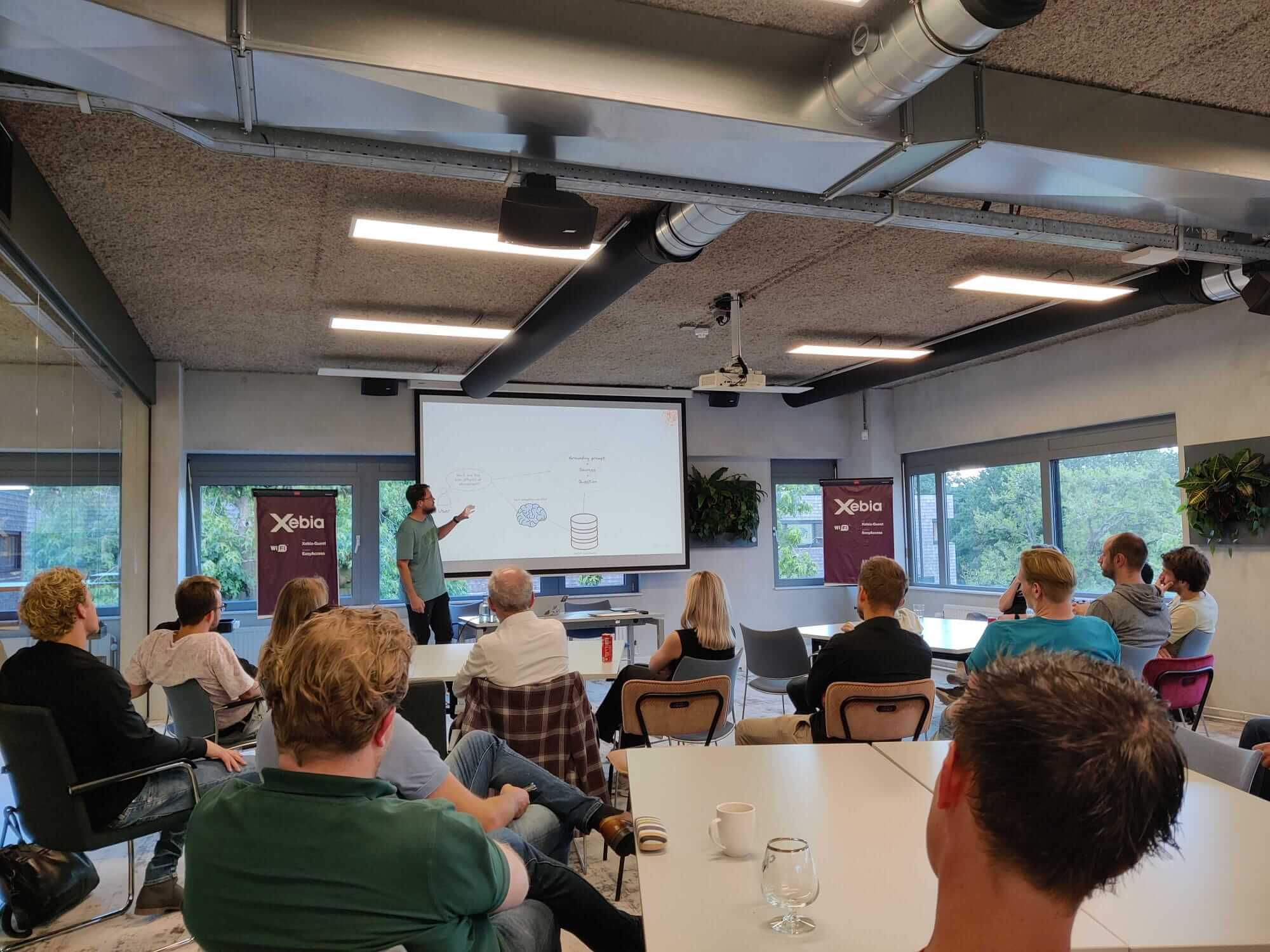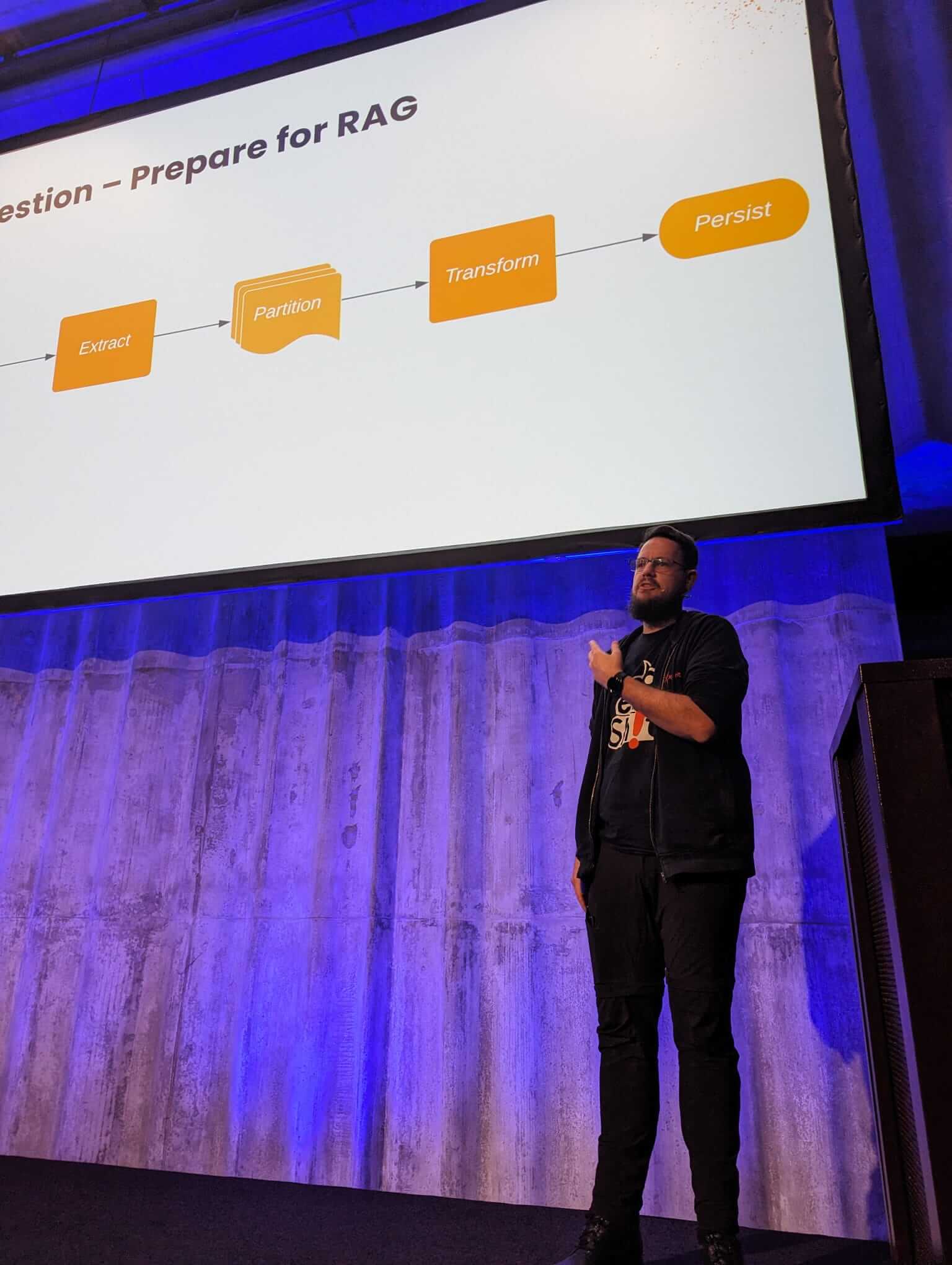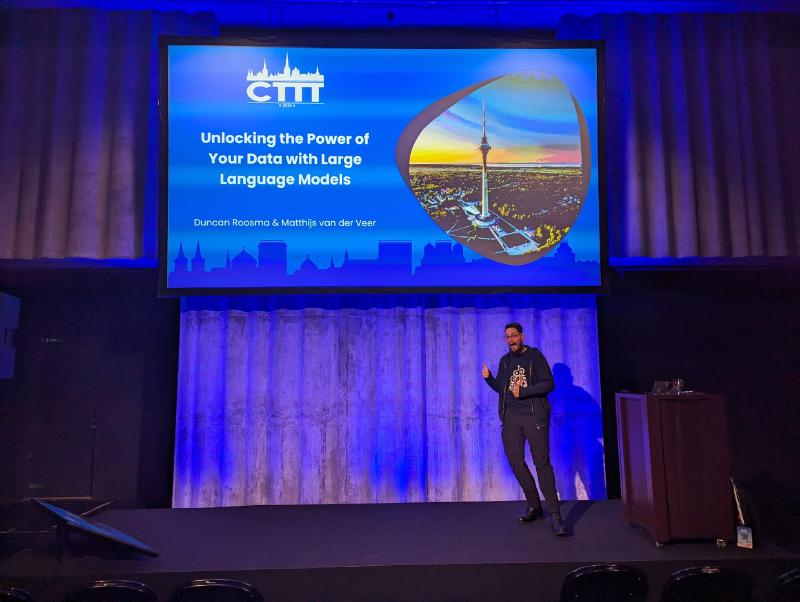On February 1, 2024, I had the honor of speaking at the Cloud Technology Townhall Tallinn 2024 (CTTT2024). This marked my first international presentation, and I’m eager to share the path that led me there. I write this reflection for myself—to catalog the journey and the lessons it bestowed upon me. Yet, I also hope it serves to inspire others to step forward and share their insights with the world.
In this article, I’ll frequently mention Matthijs van der Veer. His guidance was instrumental throughout this journey, and I am deeply appreciative of his support. Should you encounter Matthijs at a conference, I wholeheartedly recommend attending his session. He’s not only an exceptional speaker but also a wealth of knowledge.
As I reflect on the journey that led me to the stage in Tallinn, it’s clear that this adventure began not with a single step, but with a transformative period of growth and exploration in my professional life.
If you are curious about the presentation itself, I have written a separate post, “The Hello World of Generative AI: Exploring Retrieval Augmented Generation”, which delves into the content and the technology we presented.
The road to Tallinn
In consulting, moments often arise when you find yourself between assignments. During these periods, my employer encourages us to use the time to enhance our professional authority. In mid-2023, as the influence and potential of Generative AI (GenAI) for our clients became increasingly evident, I was encouraged to delve into this topic, especially given its rising interest among our customers. One area that stood out was Retrieval Augmented Generation (RAG), particularly relevant since GPT-3.5 was limited to only 4k tokens at the time, making RAG a promising technique for short-term applications. Eager to understand the technology firsthand, a colleague and I, both awaiting new projects, began our exploration. Our journey into research and experimentation helped us gain a deeper understanding. Upon sharing my insights with my manager, the inevitable question I had anticipated was posed: “When are you doing an XKE on this?” XKE, or Xebia Knowledge Exchange, is our biweekly internal “conference” where we explore topics of personal interest with our peers.
This was the moment when, despite my usual tendency to avoid such situations, I realized evasion might not be an option this time. Resigned to facing the challenge head-on, I decided to stop dodging and take the leap. Fortunately, the colleague with whom I had been exploring this topic had no reservations about presenting. In a way, I convinced myself that I could somewhat ‘hide’ behind his confidence. During our research, the subject captivated me deeply, and, being the technophile that I am, I plunged into the technicalities. This focus led to a less-than-ideal collaboration, as our attention diverged. The consequence was a presentation split into two distinct parts: one detailing the proof of concept (PoC) we developed during our investigation, and the other more focused on the technical learnings and specifics of the PoC, with me delving deeper into the latter. Given our audience comprised entirely of tech enthusiasts, I ended up leading and addressing questions for the majority of the session. This was a significant step outside my comfort zone, but I was ultimately pleased with the outcome and received positive feedback.
Fast forward a few weeks, and Microsoft unveiled the Microsoft Learn AI Skills Challenge, inviting partners to host meetups focused on Azure AI, we at Xebia decided to contribute by hosting a meetup we named ‘Azure AI Summer Jam.’. Remembering my presentation, my colleagues volunteered me to lead a session on the topic. This being a public event, my nerves were more frayed than usual. However, my remarkable colleague Matthijs, seasoned in public speaking, offered his support. We opted for a two-part session: Matthijs would cover SaaS offerings, while I would tackle the DIY solutions. The tight schedule for the event, surprisingly, worked in my favor by limiting the time I spent dwelling on my anxiety. On the day of the event, though, I was a bundle of nerves, requiring a few moments to compose myself before starting. However, as I progressed past the initial slides, I shifted into a mode of explaining to peers, an approach I usually find enjoyable. This experience was a monumental step for me, demonstrating my ability to handle public speaking despite my reservations and self-doubt. Though I did not relish the process and berated myself for letting myself get volunteered, the positive feedback and engaging discussions with attendees afterwards made it all worthwhile.

Following the success of our session and driven by Matthijs’s personal goal to increase his speaking engagements, he began submitting our presentation to various conferences through Requests for Papers (RFPs). He asked if I was interested in joining him. Despite the vivid memory of my previous anxiety, I adopted a “why not” attitude, somewhat burying my head in the sand, not fully processing the implications. Surprisingly, our proposal was accepted, and we were off to Tallinn. The realization hit me like a ton of bricks, triggering a familiar wave of panic that would visit me repeatedly in the weeks leading up to the conference. Unlike the Azure AI Summer Jam, this event was two months away, affording me plenty of time to oscillate between anxiety and dread.
In the run-up to the conference, we were asked to create a promotional video—a task I had never faced before and, akin to presenting, was not particularly excited about. However, I was fortunate to have Matthijs by my side, who not only had ample experience with such endeavors but also the patience to guide me through the process. The end result was a video that received a lot of positive feedback, although personally, I found the experience rather daunting. Despite my reservations, others seemed to appreciate it. If you’re curious, you can watch the video here and, of course, I welcome your feedback 😉.
The ironic part of that promotional video is that we claimed to have completed our presentation, which, in reality, was far from the truth. At that point, all we had was the original talk from the Azure AI Summer Jam. Both of us wanted to elevate the presentation, but faced with the looming stress of the upcoming event, I reverted to my “head in the sand” approach. We procrastinated, letting the deadline creep dangerously close. As December approached and I planned to take my usual break between Christmas and New Year’s, I added a few extra weeks off, intending to dedicate the last week of my vacation to the presentation. However, an unexpected health issue—a kidney stone—left me couch-bound, clear-minded enough to work on the presentation but physically unable to do so.
Before the vacation, we had a brief session to discuss how we wanted to change the presentation, but we never fully synchronized our plans. So, when I sat down at my computer during the last week of my vacation, driven by a mix of anxiety and the effects of pain medication, I didn’t tackle what truly needed attention. The overwhelming sense of losing control was palpable. We knew we wanted to alter the presentation, to take a different approach, yet we hadn’t concretely discussed the specifics—what changes were necessary, or how the revised outline should look. In search of comfort, I defaulted to what I knew best: I began building a demo application. However, this led to an obvious issue: without a clear direction on what we were going to discuss, what purpose did the demo serve? My actions were based solely on my interpretation of our initial, vague discussion. Predictably, this approach resulted in a demo that didn’t align with our intended message. It was only when we reconvened, with just a week to spare and my stress levels sky-high, that we managed to clarify our presentation’s direction. This clarity allowed me to adjust the demo, salvaging some of the work I had done. As we refined our focus, I began to regain a sense of control, easing the stress. Yet, the challenges weren’t over. With the presentation’s structure finalized, I had to meticulously time each section and practice my delivery. This process uncovered a new personal discomfort: speaking to an empty room. Every missed cue or stutter led to a restart, increasing my frustration and anxiety. Despite these struggles, I persisted and saw gradual improvement. Compounding these challenges was the emergence of imposter syndrome, leading me to question the value and novelty of our content. Fearing that it might bore the audience or waste their time, I faced a critical decision. With no opportunity for major revisions, I had to accept our presentation as it was and prepare to deliver it to the best of my ability.
While I was grappling with my illness, Xebia announced a new iteration of the Azure AI Summer Jam, aptly named the Azure AI Winter Jam. Scheduled in the same week as CTTT2024, it presented an ideal chance for a trial run of our presentation, advancing our deadline by two days. Despite the Winter Jam’s setup echoing the summer edition, the knowledge that we would soon be presenting internationally added an unexpected weight to my shoulders. I spent that entire day rehearsing in my car, a makeshift solution to the challenge of finding a private space in the office where I could practice aloud without reservations. Each stumble over my lines amplified my stress, pushing me to the brink of withdrawing. Thankfully, a timely conversation with my wife over the phone calmed my nerves and refocused my resolve. The trial run proved beneficial, revealing several technical issues. My computer behaved unpredictably when toggling between PowerPoint and Visual Studio. Moreover, a presenter mode in Visual Studio, designed for session-specific customization without altering my standard settings, unexpectedly launched a seldom-used browser for internet access, initiating first-time setup procedures. Despite these technical snags, we successfully delivered our presentation, receiving constructive feedback that was invaluable for our preparation.
The next day, Matthijs and I headed to Estonia, spending our arrival day wandering around Tallinn. It’s a stunning place, and we might’ve gone a bit overboard with the local food and drinks while getting ready for what was coming. That night, sleep just wouldn’t stick – I was up at 3:30 AM, brain buzzing and refusing to shut off. Not exactly the kick-off I hoped for. As we attended some sessions the next day, I could feel myself zoning out more and more, my anxiety creeping up on me. Then, something weird happened – I started shaking like I was freezing, but the room was totally fine. It wasn’t until Matthijs checked in on me, asking if I was okay, that it hit me: I was absolutely petrified, way more than I’d ever been. Looking back, I can see it was a big moment for me, even though it just piled on the stress at the time.
When it was our turn to present, I went back to an old trick of mine, trying to box up my fear and shove it aside. I guess it worked because as soon as I started talking, something clicked. Matthijs mentioned later that I loosened up after I stopped clinging to the lectern, and I shifted back into the mode I have noticed before, explaining to peers. It’s funny; I remember thinking, “Why am I even holding onto this thing?” but not really feeling the scare fade away as I let go. Inside, I was still freaking out, but it seemed like no one else could tell. By the end, I was actually pretty stoked with how it all went down—no glitches, no getting tongue-tied, just smooth sailing. And the best part? After we wrapped up, folks came up to us with questions and to chat more about it all, making the whole thing way more fun than I expected.

That evening, at the speaker dinner, the conference organizer came over to tell us that quite a few people had praised our session. Some attendees even went the extra mile to fill out feedback forms, and the comments were really encouraging. Even though it’s tough for me to fully bask in the outcome, I can’t help but feel proud. I managed to pull off something that would’ve blown my 12-year-old mind, and I didn’t drop the ball.
Why do this?
After recounting the steps of my journey to and experiences in Tallinn, it’s natural to ponder the deeper motivations behind such a venture. Why embark on this path, filled with challenges and growth opportunities alike?
As you might have realized from my story, embarking on this journey was a significant departure from my comfort zone, and honestly, it’s something I couldn’t have imagined doing just two years ago.
Starting school, my only certainty was a fascination with computers. Over time, as I explored into the vast expanse of Information Technology, I found myself drawn to development. It offered a sanctuary where I could immerse myself in code, away from the unpredictability of human interactions—a preference shaped by my experiences with bullying throughout my childhood. However, as I advanced in my career, it became evident that tackling complex problems and making a meaningful impact required more than technical prowess; effective communication and teamwork became paramount. Witnessing the transformative effect of cohesive teams and leadership, I recognized the importance of sharing knowledge, inspiring others, and storytelling. These insights reshaped my understanding of leadership and highlighted areas I needed to develop to achieve “epic shit” in my career.
My background is in product companies, where I aimed to excel as a developer and contribute to the operational smoothness. Yet, I realized that the familiarity of working with the same team didn’t challenge me in the areas I needed most—engaging with new people and earning their trust. Consulting appeared as the ideal environment to cultivate these skills, with its dynamic nature of frequently changing teams and navigating office politics promising to hone my communication and knowledge-sharing abilities.
What I hadn’t anticipated was the opportunity to also refine my skills in inspiring others and storytelling. Given my dyslexia, I’ve always preferred video and audio content, using talks and podcasts to stay on top of industry innovations. These formats not only helped me sift through the deluge of information but also sparked a desire to emulate the speakers who could simplify complex concepts and motivate their audience to explore new ideas. When joining Xebia it became clear that I inadvertently surrounded myself with not only excellent technically skilled people, but also people that are excellent at presenting, the medium that inspired me during my career with good storytelling.
While I still have much to learn about consulting, and even more about engaging an audience from the stage in the manner I aspire to, the encouragement and belief my colleagues placed in me enabled me to achieve something beyond my younger self’s wildest dreams. I’m profoundly thankful for their support and perhaps, even a bit proud of myself, though I’m still coming to terms with that feeling.
Takeaways
-
The Importance of Communication: The journey to our presentation could have been smoother and perhaps less fraught with stress if my colleague and I had dedicated time early on for a detailed discussion of our vision. Regular sync meetings to monitor our progress could have significantly enhanced our collaboration. Although I’m proud of what we achieved, a more integrated approach from the start might have elevated our presentation to a new level. Our final delivery felt like two separate parts rather than a cohesive whole, lacking seamless integration between our sections. A bit more effort could have woven our contributions more tightly together.
-
Your Slides Matter: Having always steered clear of public speaking, I hadn’t invested much effort in mastering PowerPoint. Collaborating with an experienced colleague, I discovered the pivotal role slides play in storytelling. They’re not just visual aids for the audience but also cues for the speaker. Witnessing my slides being expertly revamped in just minutes was eye-opening, underscoring their significant impact on the presentation’s effectiveness.
-
Support is Key: I couldn’t have embarked on this journey without my colleague’s encouragement and support. He played a pivotal role, handling the bulk of the preparation and allowing me to focus on areas where I felt more confident contributing. For anyone aspiring to undertake a similar challenge, having a mentor or supportive partner is invaluable. I’m immensely thankful for his guidance and support.
-
Practice Makes Perfect: Developing a clear understanding of your message is crucial, but practicing its delivery is equally important. Initially, I found rehearsing alone to be awkward, a feeling that persisted throughout the preparation. However, consistent practice gradually built my familiarity with the material, boosting my confidence in both the content and the act of presenting it. Over time, I relied less on my slides and more on my memory, which was liberating. This deep familiarity with my subject matter was what ultimately allowed me to take the stage with confidence, knowing I could convey our message without hesitation.
